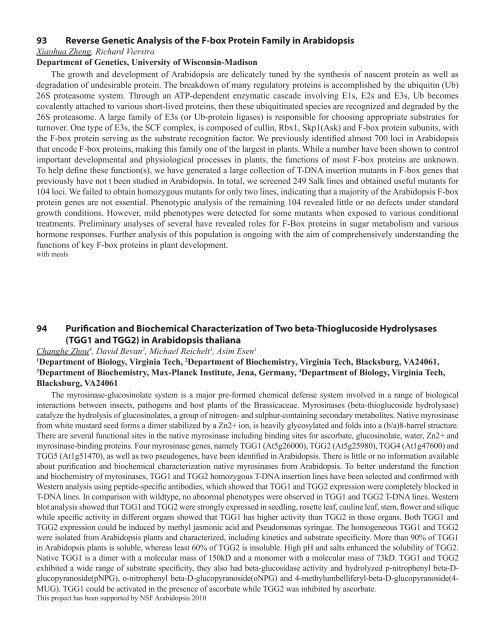75 Integrating Membrane Transport with Male Gametophyte ... - TAIR
75 Integrating Membrane Transport with Male Gametophyte ... - TAIR
75 Integrating Membrane Transport with Male Gametophyte ... - TAIR
Create successful ePaper yourself
Turn your PDF publications into a flip-book with our unique Google optimized e-Paper software.
93 Reverse Genetic Analysis of the F-box Protein Family in Arabidopsis<br />
Xiaohua Zheng, Richard Vierstra<br />
Department of Genetics, University of Wisconsin-Madison<br />
The growth and development of Arabidopsis are delicately tuned by the synthesis of nascent protein as well as<br />
degradation of undesirable protein. The breakdown of many regulatory proteins is accomplished by the ubiquitin (Ub)<br />
26S proteasome system. Through an ATP-dependent enzymatic cascade involving E1s, E2s and E3s, Ub becomes<br />
covalently attached to various short-lived proteins, then these ubiquitinated species are recognized and degraded by the<br />
26S proteasome. A large family of E3s (or Ub-protein ligases) is responsible for choosing appropriate substrates for<br />
turnover. One type of E3s, the SCF complex, is composed of cullin, Rbx1, Skp1(Ask) and F-box protein subunits, <strong>with</strong><br />
the F-box protein serving as the substrate recognition factor. We previously identified almost 700 loci in Arabidopsis<br />
that encode F-box proteins, making this family one of the largest in plants. While a number have been shown to control<br />
important developmental and physiological processes in plants, the functions of most F-box proteins are unknown.<br />
To help define these function(s), we have generated a large collection of T-DNA insertion mutants in F-box genes that<br />
previously have not t been studied in Arabidopsis. In total, we screened 249 Salk lines and obtained useful mutants for<br />
104 loci. We failed to obtain homozygous mutants for only two lines, indicating that a majority of the Arabidopsis F-box<br />
protein genes are not essential. Phenotypic analysis of the remaining 104 revealed little or no defects under standard<br />
growth conditions. However, mild phenotypes were detected for some mutants when exposed to various conditional<br />
treatments. Preliminary analyses of several have revealed roles for F-Box proteins in sugar metabolism and various<br />
hormone responses. Further analysis of this population is ongoing <strong>with</strong> the aim of comprehensively understanding the<br />
functions of key F-box proteins in plant development.<br />
<strong>with</strong> meals<br />
94 Purification and Biochemical Characterization of Two beta-Thioglucoside Hydrolysases<br />
(TGG1 and TGG2) in Arabidopsis thaliana<br />
Changhe Zhou 4 , David Bevan 2 , Michael Reichelt 3 , Asim Esen 1<br />
1<br />
Department of Biology, Virginia Tech, 2 Department of Biochemistry, Virginia Tech, Blacksburg, VA24061,<br />
3<br />
Department of Biochemistry, Max-Planck Institute, Jena, Germany, 4 Department of Biology, Virginia Tech,<br />
Blacksburg, VA24061<br />
The myrosinase-glucosinolate system is a major pre-formed chemical defense system involved in a range of biological<br />
interactions between insects, pathogens and host plants of the Brassicaceae. Myrosinases (beta-thioglucoside hydrolysase)<br />
catalyze the hydrolysis of glucosinolates, a group of nitrogen- and sulphur-containing secondary metabolites. Native myrosinase<br />
from white mustard seed forms a dimer stabilized by a Zn2+ ion, is heavily glycosylated and folds into a (b/a)8-barrel structure.<br />
There are several functional sites in the native myrosinase including binding sites for ascorbate, glucosinolate, water, Zn2+ and<br />
myrosinase-binding proteins. Four myrosinase genes, namely TGG1 (At5g26000), TGG2 (At5g25980), TGG4 (At1g47600) and<br />
TGG5 (At1g51470), as well as two pseudogenes, have been identified in Arabidopsis. There is little or no information available<br />
about purification and biochemical characterization native myrosinases from Arabidopsis. To better understand the function<br />
and biochemistry of myrosinases, TGG1 and TGG2 homozygous T-DNA insertion lines have been selected and confirmed <strong>with</strong><br />
Western analysis using peptide-specific antibodies, which showed that TGG1 and TGG2 expression were completely blocked in<br />
T-DNA lines. In comparison <strong>with</strong> wildtype, no abnormal phenotypes were observed in TGG1 and TGG2 T-DNA lines. Western<br />
blot analysis showed that TGG1 and TGG2 were strongly expressed in seedling, rosette leaf, cauline leaf, stem, flower and silique<br />
while specific activity in different organs showed that TGG1 has higher activity than TGG2 in those organs. Both TGG1 and<br />
TGG2 expression could be induced by methyl jasmonic acid and Pseudomonas syringae. The homogeneous TGG1 and TGG2<br />
were isolated from Arabidopsis plants and characterized, including kinetics and substrate specificity. More than 90% of TGG1<br />
in Arabidopsis plants is soluble, whereas least 60% of TGG2 is insoluble. High pH and salts enhanced the solubility of TGG2.<br />
Native TGG1 is a dimer <strong>with</strong> a molecular mass of 150kD and a monomer <strong>with</strong> a molecular mass of 73kD. TGG1 and TGG2<br />
exhibited a wide range of substrate specificity, they also had beta-glucosidase activity and hydrolyzed p-nitrophenyl beta-Dglucopyranoside(pNPG),<br />
o-nitrophenyl beta-D-glucopyranoside(oNPG) and 4-methylumbelliferyl-beta-D-glucopyranoside(4-<br />
MUG). TGG1 could be activated in the presence of ascorbate while TGG2 was inhibited by ascorbate.<br />
This project has been supported by NSF Arabidopsis 2010





